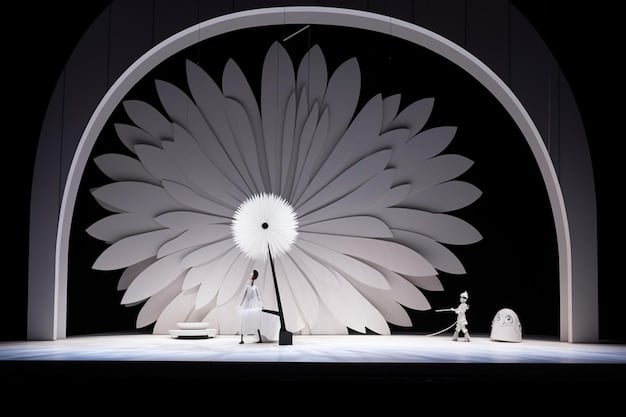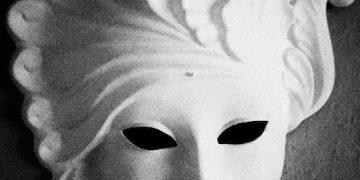Decoding Symbolism: Unveiling Motifs in Drama Reviews

Decoding the Symbolism involves a deep analysis of recurring motifs in dramatic works, revealing layered meanings and enhancing understanding of themes, character development, and the playwright’s intent.
Ever wondered about the hidden language behind a playwright’s choices? Decoding the Symbolism in drama isn’t just about spotting objects; it’s a profound exploration of recurring motifs that enrich the narrative.
The Essence of Motifs in Drama
Motifs serve as vital building blocks in the architecture of a play, providing texture and depth to the storytelling. They are not mere decorations but recurring elements that carry significant symbolic weight, influencing how we interpret characters and their journeys.
Understanding motifs allows audiences to engage more deeply with the work, uncovering subliminal messages and grasping the core themes that resonate throughout the play.

Recognizing Common Motifs
Identifying motifs often begins with noting recurring images, objects, or even phrases. Once these elements are recognized, the next step is to analyze their significance within the context of the story.
- Recurring Imagery: Analyze repeated visual elements and their implications.
- Object Symbolism: Interpret the meanings behind significant objects.
- Phrases and Dialogue: Note repeated phrases or lines and their impact.
- Thematic Resonance: Understand how motifs reinforce central themes.
Motifs aren’t always obvious; sometimes they are intricately woven into the fabric of the narrative, requiring careful attention to detail to spot and interpret.
In conclusion, understanding the essence of motifs can profoundly elevate one’s understanding of the drama, revealing layers of meaning and artistic intention.
The Significance of Recurring Symbols
Recurring symbols act as potent emotional shortcuts, offering audiences a deeper, more instinctive understanding of the drama’s core messages. These symbols often transcend cultural and linguistic barriers, appealing directly to our shared human experiences.
By paying close attention to the symbolic language employed by playwrights, we uncover hidden narratives and connect with the play on a more profound level.
Analyzing Symbol Repetition
The repetition of certain symbols throughout a play often signals their importance to the overarching narrative. Different contexts can subtly alter the meaning of a symbol, adding further layers of complexity.
Examining these patterns enables us to appreciate how the playwright employs symbols not merely as static representations but as dynamic agents in the unfolding drama.

Examples in Dramatic Literature
Consider the motif of light and darkness in Shakespeare’s “Hamlet,” where darkness represents uncertainty, corruption, and the unknown, while light symbolizes truth and clarity. The constant interplay between these symbols underscores the play’s central themes of moral ambiguity and existential dread.
- “Hamlet:” Light and darkness as symbols of truth and corruption.
- “Oedipus Rex:” Blindness as a metaphor for ignorance and enlightenment.
- “A Streetcar Named Desire:” Shadows symbolizing hidden truths and suppressed desires.
Symbols such as these are not limited to classic plays; they continue to be used in contemporary drama to communicate profound and universal themes.
Recurring symbols enrich dramatic works, offering audiences a deeper, more nuanced understanding of complex themes and character arcs.
Motifs and Character Development
Motifs are powerful literary tools that reflect and influence character arcs. By associating specific motifs with certain characters, playwrights can provide insights into their internal states, motivations, and transformations.
The interplay between characters and their associated motifs can enhance narrative depth, creating a symbiotic relationship between the character’s development and the plot’s progression.
Linking Motifs to Protagonists
When analyzing character development, it’s essential to consider how motifs evolve with the characters. A protagonist’s journey is often mirrored by the changing symbolism of their associated motifs.
Examining these links can illuminate a character’s psychological complexities, revealing how they internalize and react to external events and relationships.
Take, for example, the recurring motif of water in Ibsen’s “A Doll’s House.” Initially associated with freedom and escape for Nora, it later symbolizes her moral cleansing and rebirth as an independent woman. The evolution of this motif mirrors Nora’s journey from a subservient wife to an enlightened individual.
Analyzing Symbolic Transformations
The transformation of motifs often signifies significant changes within a character’s psyche or circumstances. This transformation can be subtle or dramatic, providing audiences with key insights into the protagonist’s evolution.
- Ibsen’s “A Doll’s House:” Water’s shifting symbolism reflecting Nora’s awakening.
- Miller’s “Death of a Salesman:” Seeds symbolizing Willy Loman’s desire for legacy.
- Williams’ Glass Menagerie: The glass unicorn representing Laura’s fragility and uniqueness.
Symbolic transformations also serve to emphasize a character’s growth, decline, or ultimate fate within the dramatic narrative.
By analyzing the dynamic relationship between character development, motifs enriches the audience experience, fostering a deeper appreciation for the playwright’s craft and the characters’ humanity.
The Role of Color Motifs in Setting Mood
Color motifs are invaluable tools for setting the mood and enhancing emotional resonance within a play. The strategic use of color can evoke specific feelings, create striking visual contrasts, and even hint at underlying themes.
Masterful playwrights harness the psychological impact of color to elevate the storytelling, adding depth and nuance to the overall dramatic experience.
Color Associations
Colors are loaded with cultural and psychological connotations. Understanding these associations enables audiences to grasp the subtle emotional cues embedded within the play’s visual design.
For example, the recurring use of red might symbolize passion, violence, or danger, while blue could represent tranquility, sadness, or reflection. The interplay of these colors creates layers of meaning that enhance the drama’s themes.
Case Studies in Color Symbolism
Tennessee Williams, in “A Streetcar Named Desire,” uses color to underscore Blanche DuBois’s fragile mental state and fading beauty. Her obsession with white clothing symbolizes her desperate attempt to maintain an illusion of purity, while the harsh, unflattering colors of New Orleans expose her true reality.
- “A Streetcar Named Desire:” The color white symbolizing Blanche’s illusion of purity.
- “Macbeth:” The color red, symbolizing guilt, blood, and violence.
- “The Importance of Being Earnest:” The use of bright, gaudy colors to reflect the satire of high society.
Color motifs in a drama are not superficial; they are integral to conveying mood, establishing symbolism, and enhancing the overall thematic structure of the piece.
By recognizing and interpreting color motifs, audiences gain a more profound appreciation for the playwright’s artistry and the emotional complexities of the drama.
Sound Motifs and Their Impact
Sound motifs, often underappreciated, contribute significantly to the dramatic atmosphere, reinforcing themes and heightening emotional impact. From recurring musical cues to ambient effects, strategic sound design can deeply affect audience perception.
Playwrights who carefully orchestrate sound motifs reveal their dedication to detail, using auditory cues to enhance the narrative’s depth and resonance.
Creating Sensory Experiences
Sound plays a pivotal role in creating immersive sensory experiences for the audience. Recurring sounds can function as leitmotifs, associating with specific characters, places, or themes.
These sonic cues serve as subtle reminders, reinforcing the play’s core ideas and eliciting emotional responses without relying solely on dialogue or visual elements.
Examples of Sound Symbolism
In Arthur Miller’s “Death of a Salesman,” the sound of a flute evokes Willy Loman’s idealized past and lost opportunities. This recurring melody acts as a haunting reminder of his failed dreams and the chasm between reality and aspiration.
- “Death of a Salesman:” The flute symbolizing Willy Loman’s lost dreams.
- “The Glass Menagerie:” The recurring music highlighting emotions of loneliness and nostalgia.
- “Who’s Afraid of Virginia Woolf?:” The sound of laughter signaling tension and unspoken pain.
These examples illuminate how sound motifs enrich dramatic works, providing another sensory layer that deepens audience engagement and enhances thematic understanding.
Analyzing a play’s soundscape reveals the playwright’s meticulous effort to craft a multi-sensory experience that elevates emotional impact and emphasizes narrative themes.
Motifs in Set Design and Staging
Motifs extend beyond dialogue and characterization, permeating set design and staging to reinforce thematic elements. These visual motifs add depth, enhancing storytelling through symbolic physical arrangements.
Incorporating motifs into set and staging offers a profound, often subliminal, reinforcement of the play’s underlying messages, significantly enriching the audience’s experience.
Visual Cues
Set design is powerful in creating visual metaphors. From recurring architectural elements to strategically placed props, each detail plays a part in shaping the play’s message.
For example, a dilapidated house might signify decay, whereas a minimalist stage could highlight emotional rawness and authenticity. Analyzing these set pieces reveals insights into the playwright’s vision.
Examples in Set and Stage Design
The oppressive, claustrophobic setting of Eugene O’Neill’s “Long Day’s Journey into Night” reflects the familial tensions and psychological imprisonment within the Tyrone family. The constant presence of fog outside the house symbolizes the characters’ clouded perceptions and inability to escape their tragic fate.
- “Long Day’s Journey into Night:” Oppressive physical setting mirroring familial tensions.
- “Waiting for Godot:” A barren tree symbolizing hopelessness and the passage of time.
- “No Exit:” A confined room representing the characters’ eternal damnation.
These examples demonstrate how set design and staging communicate profound themes, adding layers of meaning and bolstering emotional impact in theatrical productions.
Set design is vital in weaving motifs, creating an immersive, symbolic environment that underscores the play’s most essential themes.
| Key Point | Brief Description |
|---|---|
| 🎭 Essence of Motifs | Recurring elements that add depth to storytelling. |
| 💡 Symbol Significance | Recurring symbols that reflect narrative importance. |
| 🎨 Color’s Impact | Sets mood and enriches the emotional context. |
| 🎶 Sound’s Role | Enhances atmosphere and reinforces major themes. |
FAQ
▼
A motif is a recurring element, such as a symbol, image, or concept, that appears multiple times in a dramatic work. It supports and reinforces the play’s central themes by adding layers of meaning and complexity.
▼
Recognizing motifs allows for a deeper understanding of the play’s message. It exposes hidden narratives, and helps reveal the playwright’s intent by bringing awareness of the themes that resonate throughout.
▼
Color motifs influence the audience by setting a particular mood and enhancing the emotional impact of the drama. Colors carry cultural and psychological associations that can evoke specific feelings and reactions.
▼
Yes, sound motifs can change the audience’s perception of a character by associating certain sounds with their actions, thoughts, or past events. These auditory cues create an emotional connection between character and audience.
▼
Set design incorporates motifs through visual cues, such as recurring architectural features or strategically placed props. These elements reinforce themes and contribute to the drama’s storytelling capabilities by offering symbolic representations of the play.
Conclusion
In sum, decoding the symbolism and understanding the intricate dance of motifs elevates the dramatic experience, offering deeper insight of the playwright’s intent and enriching the emotional resonance of the story while highlighting the power of recurrent elements in narrative craft.





